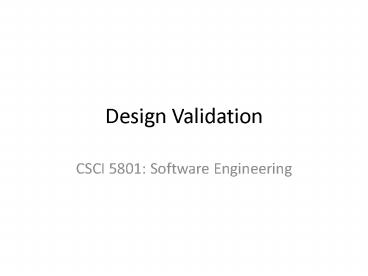Design Validation - PowerPoint PPT Presentation
1 / 21
Title:
Design Validation
Description:
Design Validation CSCI 5801: Software Engineering Design Validation Design Validation Does design match requirements? Are there components/objects/methods for each ... – PowerPoint PPT presentation
Number of Views:170
Avg rating:3.0/5.0
Title: Design Validation
1
Design Validation
- CSCI 5801 Software Engineering
2
Design Validation
3
Design Validation
- Does design match requirements?
- Are there components/objects/methods for each
step in scenarios? - Are all nonfunctional requirements addressed?
- Is design good?
- Maximal cohesion within a component/class
- Minimal coupling between components/classes
- Maximum fault tolerance
4
Design Walkthroughs
- For each scenario in requirements, walk through
step by step - Is there component for each step?
- Does that component have a method in its API for
the previous component to call? Is needed
information passed/returned? - Does each component store the correct data to
perform its role in this scenario? - Are there components/methods for each of the
exceptions that might occur?
5
Best Tool Sequence Diagrams
6
Example Scenario
- Add Scenario
- Description
- A student adds a course by entering a course
number and selecting a section. - Initial Assumption
- Student has logged in and navigated to ADD
screen, and has selected a course to add.
7
Example Scenario
- Normal Steps
- System populates dropdown list of courses.
- Student selects a course from the list.
- A drop down with open sections (including their
times) is populated. - The student selects on and presses ADD.
- The student is added to the course roster.
- An acknowledgement of the add is displayed.
- The student may add more courses, or exit to th
main menu.
8
Example Scenario
- Exceptions
- All sections of the selected course may be
closed, in which case a message is popped up
instead of the drop down being populated. - The course may be closed before the student
presses ADD, due to other students adding, in
which case a message is displayed and the list of
open sections displayed again. - System State upon Completion
- The student ID is added to the roster of the
section chosen.
9
Cohesion and Coupling
- Cohesion A component/class should have one
purpose - Easier for single design team to implement,
maintain - CouplingDifferent components should have
minimal communications - Few public methods with few parameters
- Easier to implement/test interfaces
- Strong cohesion weak coupling modular design
10
Some Types of Cohesion
- Data cohesion
- Component has all responsibility for single major
piece of data - Example All access to class roster
- Functional cohesion
- Component contains related functions
- Example Math library
- Procedural cohesion
- Component handles all steps in single process
- Example Payment component for registration
handles all billing steps (parking fees, billing
info, payment)
11
Some Types of Cohesion
- Communicational cohesion
- Component handles all access to external entity
- Example InventoryDB component handles all
communication to Course Inventory, using SQL - Temporal cohesion
- Component contains all code for specific stage of
system - Example Startup module creates and links all
components, loads data from files
12
Registration Example
13
Registration Example
- Not cohesive
- Section information
- Section roster
- Too much coupling
- Section component must call course component for
all information to display
Two different concepts used in two different
scenarios
14
Better Solution
15
Desired Non-functional Attributes
- Maintainability
- How hard will it be to make anticipated changes?
- Performance
- Can the scale to higher loads if necessary with
minor design changes (i.e, more servers)? - Testability
- Can requirements be tested at component level?
- Can automated testing be used?
- Traceability
- Is this component related to some scenario in the
requirements?
16
Desired Non-functional Attributes
- Flexibility
- How easily can the system adapt to unusual
conditions? - Portability
- Could you get the system to run on a new
platform? - Reusability
- What parts of the system could you use in a new
system? - Interoperability
- Can the system talk to other relevant systems?
17
Fault-Tolerant Design
- Prevent things from going horribly wrong
- Identify bad things that can happen
- Often involves data integrity/security
- Can assign degrees of risk to each
- Determine whether they can occur in present
design - If so, improve design to minimize risk
18
Fault-tolerant Design
- Examples from registration system
- Can roster database be deleted?
- High risk!
- Can intruder read files (in violation of FERPA)?
- Medium risk
- Can a student add a course but not be added to
the roster? - Lower risk
19
Fault-tolerant Design
- Can roster database be deleted? Yes
- Possible causes
- Database hacked through web
- Database server physically destroyed
- Design solutions
20
Fault-tolerant Design
- Can student records be read? Yes
- Possible causes
- Records stored in non-encrypted form
- Design solutions
21
Fault-tolerant Design
- Can student add course but not be added to
roster? Yes - Possible causes
- Database server crashes before updated with new
course - Design solutions

